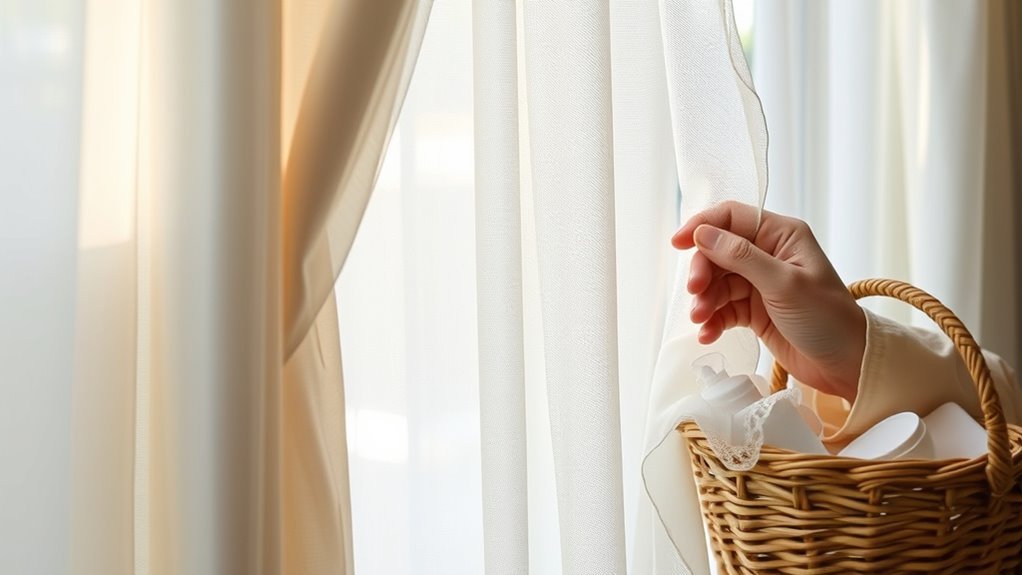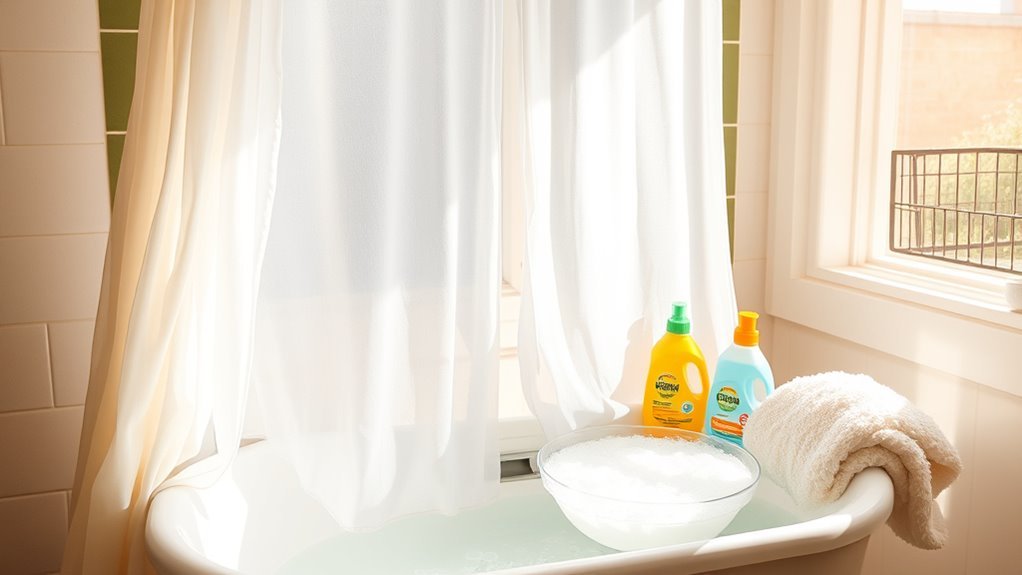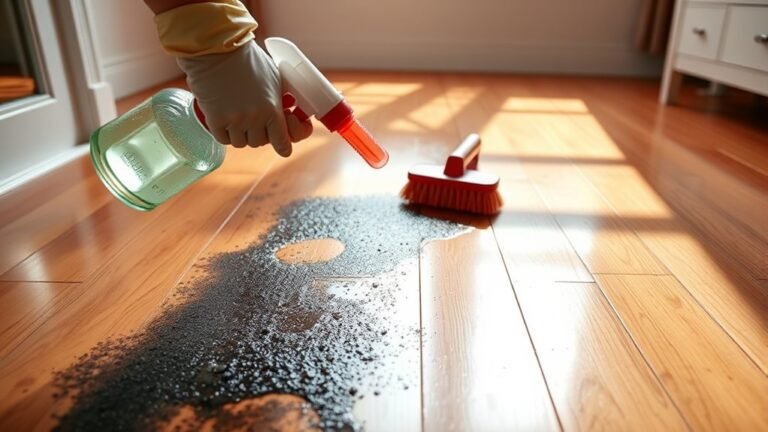Washing Curtains Without Damage
When washing your curtains, start by checking the care label for fabric type and washing instructions. Remove hooks and shake off dust before using a gentle cycle with cold water in the machine or hand wash with mild detergent to avoid damage. Air dry them away from direct sunlight and avoid wringing to prevent shrinkage. To keep your curtains looking their best, you’ll want to explore proper stain removal, drying techniques, and maintenance tips next.
Understanding Different Curtain Fabrics

Before you start washing your curtains, it’s important to know what fabric they’re made from, since different materials require different care. Understanding your curtain fabric is key to preserving its look and feel, giving you freedom from constant replacement. Natural fabrics like cotton and linen are breathable but may shrink if washed improperly, so cold water and gentle cycles are fabric care essentials. Synthetic materials like polyester tend to be more durable and wrinkle-resistant, offering you easier maintenance. Velvet or silk, on the other hand, need special attention to avoid damage. By tailoring your washing method to the fabric, you’ll apply effective curtain longevity tips that keep your curtains vibrant and intact longer. Knowing your fabric means freedom to care without worry or damage.
Checking Care Labels Before Washing
Before you start washing your curtains, take a close look at the care labels to understand the symbols and instructions. These labels tell you the fabric type and the best washing methods to use. Following them helps prevent damage and keeps your curtains looking their best.
Understanding Label Symbols
Although it might seem tedious, checking the care label on your curtains is essential to avoid damage during washing. Those tiny symbols carry powerful information about fabric care, guiding you on water temperature, bleach use, drying methods, and ironing. Understanding label meanings frees you from guesswork and prevents costly mistakes like shrinking or color fading. You’ll find icons for machine wash cycles, hand wash, or dry clean only, each telling you exactly how gentle or intense the process should be. By mastering these symbols, you gain control over how your curtains are treated, preserving their look and feel. So next time, don’t skip the label—it’s your shortcut to washing curtains without damage and enjoying your freedom to clean confidently.
Identifying Fabric Types
One key step to washing curtains safely is identifying their fabric type, which you can usually find on the care label. Knowing whether your curtains are made from natural fibers, synthetic materials, or fabric blends helps you choose the right washing approach without risking damage. Always check the label carefully; it’s your guide to preserving the fabric’s integrity and color. Here’s a quick overview of common curtain materials and their characteristics:
| Curtain Material | Common Fabric Blend | Care Tip |
|---|---|---|
| Cotton | 100% cotton | Machine washable, gentle cycle |
| Polyester | Polyester blend | Durable, dries quickly |
| Linen | Linen-cotton blend | Hand wash or delicate cycle |
| Silk | Silk blend | Dry clean recommended |
| Velvet | Synthetic blend | Spot clean or dry clean |
Recommended Washing Methods
Since each curtain fabric has unique care needs, always check the care label before washing to avoid damage. That label is your best guide for curtain cleaning, telling you whether to hand wash, machine wash, or dry clean. Ignoring these instructions can shrink, fade, or weaken your curtains, limiting your freedom to refresh your space. If the label recommends machine washing, use a gentle cycle with mild detergent to protect fabric care. For delicate fabrics like silk or lace, hand washing or professional cleaning is safer. Also, pay attention to water temperature and drying methods specified on the label to maintain your curtains’ shape and texture. By respecting care labels, you guarantee your curtains stay beautiful and last longer, giving you freedom to enjoy your home your way.
Preparing Curtains for Cleaning
Before you start washing your curtains, you’ll want to prepare them properly to avoid any damage. First, check the curtain materials—different fabrics need different care. Delicate silks or lace, for example, require gentler handling than sturdy cotton or polyester. Next, remove any hooks, rings, or hardware that could snag the fabric during cleaning. Give your curtains a good shake or vacuum with a soft brush attachment to remove dust and loose dirt. Gather the right cleaning tools: mild detergent, a gentle brush, and a large basin or washing machine with a delicate cycle option. By taking these careful steps, you’ll protect your curtains and enjoy the freedom of fresh, clean window treatments without worry. Preparation is key to preserving their beauty and lifespan.
Hand Washing Curtains Safely

When hand washing your curtains, you’ll want to pick a gentle detergent to protect the fabric’s fibers. Be careful not to use too much soap, and rinse thoroughly to avoid residue. After washing, use proper drying techniques like air drying flat or hanging them up to keep their shape intact.
Choosing Gentle Detergents
Although you might be enthusiastic to get your curtains clean, choosing the right detergent is essential to prevent damage during hand washing. Opt for gentle formulas that protect delicate fabrics while effectively removing dirt. Eco friendly options are great if you want to care for your home and the planet. Avoid harsh chemicals that can weaken fibers or cause discoloration.
Here’s a quick guide to help you pick the best detergent:
| Detergent Type | Benefits |
|---|---|
| Mild liquid soap | Soft on fabric, easy rinsing |
| Baby shampoo | Ultra gentle, fragrance-free |
| Wool detergent | Protects delicate fibers |
| Eco friendly detergent | Biodegradable, toxin-free |
| Plant-based soap | Natural ingredients, sustainable |
Choosing wisely lets you wash your curtains safely and keeps your freedom to refresh your space without worry.
Proper Drying Techniques
Choosing the right detergent helps protect your curtains during washing, but how you dry them matters just as much to maintain their shape and fabric quality. After hand washing, avoid wringing your curtains; instead, gently press out excess water to prevent damage. Air drying is your best bet—it’s gentle and preserves the fabric’s integrity. Hang your curtains on a rod or clothesline in a well-ventilated area, away from direct sunlight to prevent fading. Make certain they’re evenly spread to avoid wrinkles and stretching. Proper fabric care during drying guarantees your curtains stay fresh and beautiful without shrinking or losing their softness. By mastering these drying techniques, you keep your curtains looking great and enjoy the freedom of fresh, damage-free fabric in your space.
Machine Washing Curtains: Best Practices
If you want to machine wash your curtains without causing damage, it’s essential to follow a few key steps. Start by checking the care label to understand fabric care essentials. Use a gentle cycle and cold water to protect delicate fibers. Remove hooks or rings to prevent snags. Avoid overloading the machine; curtains need space to move freely. These curtain maintenance tips guarantee your curtains stay fresh and last longer.
| Schritt | Tipp |
|---|---|
| 1. Check label | Know fabric care essentials |
| 2. Remove hardware | Prevent snags & tears |
| 3. Use gentle cycle | Protect delicate fabric |
| 4. Cold water wash | Avoid shrinking & fading |
| 5. Don’t overload | Curtains need room to move |
Follow these best practices to keep your curtains looking great and free.
Using the Right Detergents and Cleaning Agents

When washing your curtains, using the right detergent is key to preserving their fabric and color. You’ll want to choose detergent types that are gentle, like those labeled for delicate or hand-wash fabrics. Harsh chemicals can strip dyes and weaken fibers, so avoid strong cleaning agents with bleach or enzymes. If your curtains are made from natural fibers like cotton or linen, mild liquid detergents work best. For synthetic fabrics, look for detergents designed to protect synthetic blends without causing buildup. Always skip fabric softeners—they can leave residues that attract dust. By selecting the right cleaning agents, you maintain your curtains’ look and feel, giving you freedom to refresh your space without worry or damage.
Drying Curtains Without Causing Damage
After washing your curtains, you’ll want to dry them carefully to avoid shrinkage and fading. Choosing the right drying method helps keep the fabric’s shape and color intact. Let’s explore how to dry your curtains without causing damage.
Optimal Drying Techniques
Although drying curtains might seem straightforward, using the wrong method can easily lead to shrinkage, color fading, or fabric damage. To keep your curtains looking fresh and vibrant, choose drying techniques that respect their delicate nature. Air drying is your best bet—it’s gentle, preserves fabric integrity, and avoids harsh heat. Remember, fabric softeners can enhance softness but might reduce flame resistance, so use them sparingly if safety is a concern. For ideal drying:
- Hang curtains on a sturdy rod or clothesline, allowing air to circulate freely.
- Avoid direct sunlight to prevent color fading.
- Gently shake curtains before hanging to reduce wrinkles and speed drying.
Avoiding Fabric Shrinkage
Since curtains are often made from delicate fabrics, drying them improperly can lead to unwanted shrinkage that ruins their fit and appearance. To keep your curtains free and flowing, start with proper fabric pre treatment—this helps relax fibers before washing. Always choose a gentle wash temperature; cooler water prevents tightening of threads that causes shrinkage. After washing, avoid wringing or twisting your curtains. Instead, gently press out excess water and lay them flat or hang them to air dry naturally. If you must use a dryer, opt for the lowest heat setting and remove curtains while slightly damp to prevent over-drying. Taking these steps gives you the freedom to refresh your space without compromising your curtains’ size or shape.
Preventing Sunlight Fading
When drying your curtains, you’ll want to protect them from direct sunlight to prevent fading. Exposure to harsh sun rays can quickly dull fabric colors, robbing your space of its vibrant freedom. To keep your curtains looking fresh, consider these tips:
- Use UV coatings or sprays designed for fabric; they provide an invisible shield against sunlight damage.
- Hang curtains in shaded areas or indoors near open windows where air circulates but sunlight is diffused.
- Rotate curtains regularly to guarantee even wear and minimize prolonged exposure on one side.
Ironing and Steaming Tips for Curtains
Mastering a few key ironing and steaming techniques can make all the difference in keeping your curtains looking fresh and wrinkle-free. First, always check the care label to understand the best approach for your curtain fabric. Some delicate materials like silk or lace may need low heat or gentle steam settings, while sturdier fabrics tolerate higher temperatures. Use a pressing cloth to protect the fabric from direct heat, preventing shiny marks or burns. When steaming, keep the iron slightly away from the fabric to avoid water spots and allow the steam to relax wrinkles naturally. Taking these simple steps gives you the freedom to refresh your curtains effortlessly, maintaining their beauty without risking damage or losing that crisp, clean look you want.
Dealing With Stains on Curtains
A stain on your curtains can be frustrating, but quick action can prevent it from setting permanently. When dealing with stains, understanding fabric stain types helps you choose the best stain removal techniques. For example, oil-based stains require different treatment than water-based ones.
To tackle stains effectively:
- Identify the stain type to select the right cleaning agent.
- Blot gently instead of rubbing to avoid fabric damage.
- Test stain removal methods on a hidden area before full application.
Preventing Future Damage and Maintaining Cleanliness
Treating stains promptly helps keep your curtains looking fresh, but preventing future damage is just as important. You can take control by establishing a regular cleaning frequency that suits your lifestyle and curtain fabric. Avoid harsh chemicals and opt for gentle detergents to preserve the material’s integrity. Regular curtain maintenance, like dusting or vacuuming with a soft brush, prevents dirt buildup that can cause wear over time. Also, rotating curtains occasionally helps distribute sun exposure evenly, reducing fading. When handling your curtains, be gentle—rough treatment can weaken fibers and shorten their lifespan. By staying consistent and mindful, you’ll keep your curtains looking vibrant and free from damage, all while enjoying the freedom of a clean, beautiful space without the hassle.
Häufig gestellte Fragen
Can I Wash Curtains With Other Laundry Items?
You want to clean your curtains and your clothes, to save time and effort, to simplify your routine. But curtain fabrics vary—some delicate, some sturdy—and washing temperatures matter. Mixing curtains with other laundry items can risk damage or color transfer. You’re free to choose, but it’s wise to separate them, use gentle cycles, and cold water. That way, you protect your curtains and keep your laundry harmony intact.
How Often Should I Wash My Curtains?
When it comes to curtain care, you don’t have to stick to a strict schedule, but setting a washing frequency helps keep them fresh. Generally, washing your curtains every 6 to 12 months is enough to maintain their look and feel. If you live somewhere dusty or have allergies, you might want to wash them more often. Just trust your instincts and your space’s vibe to decide when it’s time.
Are There Eco-Friendly Detergents Safe for Curtains?
You deserve to care for your home with gentle grace, and yes, there are eco-friendly detergents safe for curtains. Look for biodegradable options made with natural ingredients—they’re kind to both your fabrics and the planet. These products let you embrace freedom from harsh chemicals while keeping your curtains fresh and vibrant. Choosing such thoughtful cleaners means you’re not just protecting your space but also nurturing the world around you.
Can Dry Cleaning Damage Delicate Curtains?
You might worry that dry cleaning could damage delicate curtains, but it really depends on the fabric types involved. Some materials, like silk or velvet, can be sensitive to harsh chemicals or heat used in dry cleaning. However, professional cleaners usually know how to handle these fabrics gently. If you want to keep your curtains looking fresh without risking harm, always check the care label or ask your cleaner about their process.
How Do I Remove Mildew From Curtains?
Did you know that 60% of household mold issues start in soft fabrics like curtains? To remove mildew, soak your curtains in a mixture of white vinegar and water for an hour, then wash with mild detergent. For mildew prevention tips, keep your curtains dry and guarantee good airflow. Using curtain care techniques like regular washing and avoiding dampness will help you enjoy fresh, freedom-friendly living spaces without that stubborn mildew smell.






